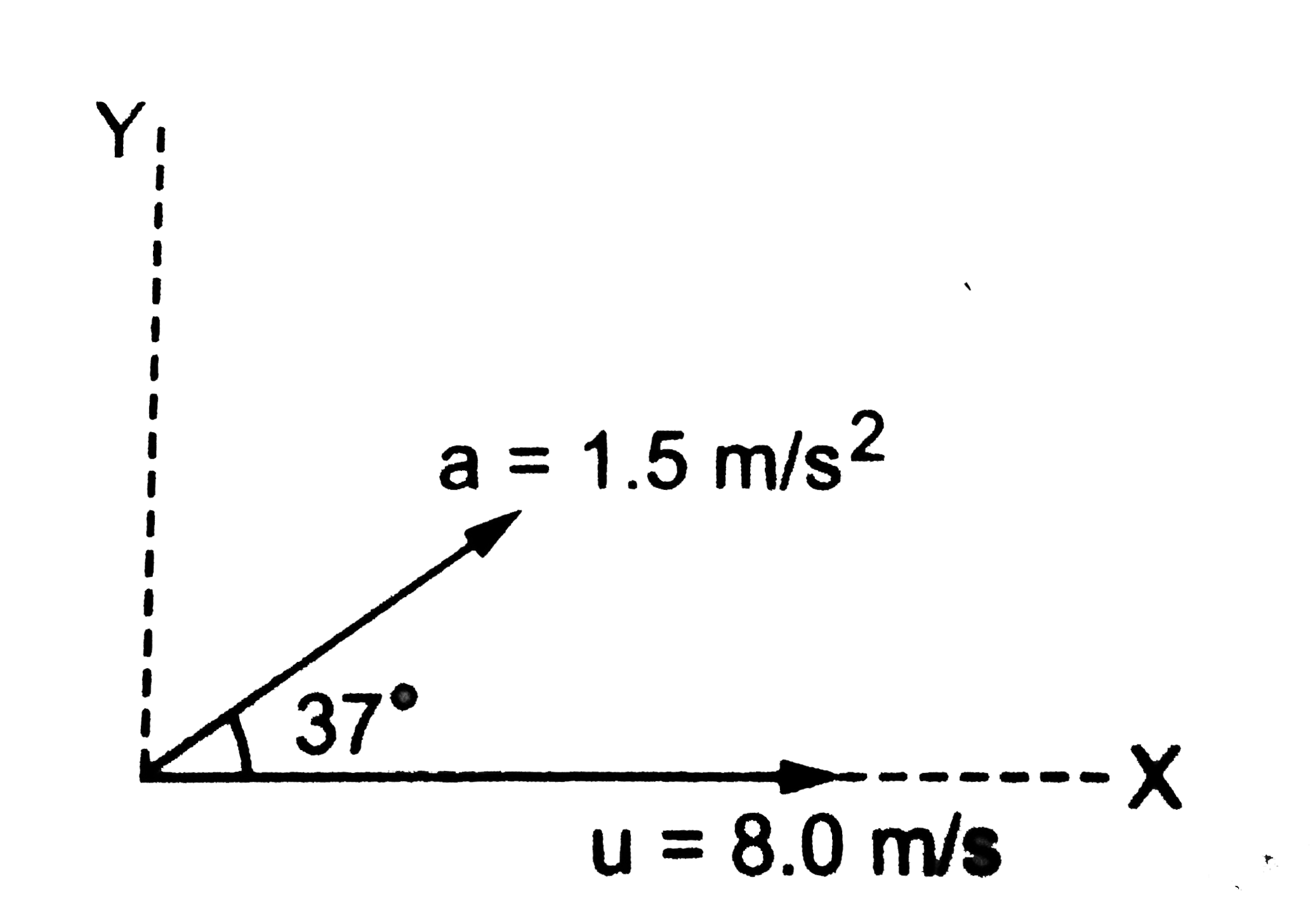A particle movesin the X-Y plane with a constasnt acceleration of 1.5ms2 in the direction making an angle of 370 with the X-axis.At t=0 the particle is at the orign and its velocity is 8.0 m/s along the X-axis. Find the velocity and the position of the particle at t=4.0 s.
 Solution in Tamil
Solution in Tamil
ax=(1.5ms2)(cos370)
=(1.5ms2)×45=1.2ms2
and a_y=(1.5 m/s^2)(sin37^0)<br>=(1.5 m/s^2) xx 3/5 = 0.90 m/s^2.<br>The∈itialvelocityhascompo≠nts<br>u_x=8.0 m/s<br>andu_y=0<br>At t=0, x=0 and y=-0<br>Thex−compo≠ntofthevelocityattimet=4.0sisgivenby<br>v_x=u_x+a_xt<br>=8.0 m/s+(1.2 m/s^2)(4.0s)<br>=8.0 m/s+4.8 m/s=12.8 m/s.<br>They−compo≠tofvelocityatt=4.0sigivenby<br>v_y=u_y+a_y t<br>=0+(0.90 m/s^2)(4.0s)=3.6 m/s<br>Thevelocityofthepartic≤∗t=4.0is<br>v=sqrt(v_x^2+v_y^2)= sqrt(12.8 m/s)^2 +(3.6 m/s)^2<br>=13.3 m/s.<br>Thevelocitymakesan∠θwiththeX−aξswhere<br>tantheta= (v_y)/(v_x) = (3.6 m/s)/(12.8 m/s) = 9/32<br>Thex−c∞rdiNAteatt=4.0sis<br> x= u_x t+1/2 a_x t^2<br>=(8.0 m/s)(4.0 s)+1/2 (1.2m/s^2)(4.0s)^2<br>=32m+9.6 m 41.6m.
The y=component at t=4.0 is
y=uyt+12at2
=12(0.90ms2)(4.0s)2
=7.2m
Thus, the particle is at (41.6 m, 7.2 m) at 4.0 s.
Topper's Solved these Questions
- REST AND MOTION : KINEMATICSBook:HC VERMAChapter:REST AND MOTION : KINEMATICSExercise:worked out Examples
Explore 20 Videos
- REST AND MOTION : KINEMATICSBook:HC VERMAChapter:REST AND MOTION : KINEMATICSExercise:Question for short Answer
Explore 14 Videos
- PHYSICS AND MATHEMATICSBook:HC VERMAChapter:PHYSICS AND MATHEMATICSExercise:Exercises
Explore 34 Videos
- ROTATIONAL MECHANICSBook:HC VERMAChapter:ROTATIONAL MECHANICSExercise:Exercises
Explore 86 Videos
Similar Questions
A man at a speed of 6 km/hr for 1 km and 8 km/hr for the next 1 km. What is t his average speed for the walk of 2 km?
View SolutionGalileo was punished by the Church for teaching that the sum is stationary and the earth moves around it. His opponents held the view that the earth is stationary and the sun moves around it. If the absolute motion has no meaing,are the two view points not equally correct or equally wrong?
View SolutionA vector →A makes an angle of 20∘and→B makes an angle of 110∘ with the X-axis. The magnitude of these vectors are 3 m and 4 m respectively.Find the resultant
View SolutionA wheel is making revolutions about its axis with uniform angular acceleration. Starting from rest, till it reaches 100 rev/sec in 4 seconds. Find the angular acceleration.
View SolutionVelocity (in m/s) of a particle moving along x-axis varies with time as, v= (10+ 5t -t^2) At time t=0, x=0. Find (a) acceleration of particle at t = 2 s and (b) x-coordinate of particle at t=3s
View SolutionAcceleration of a particle in x-y plane varies with time as a=(2t hati+3t^2 hatj) m//s^2 At time t =0, velocity of particle is 2 m//s along positive x direction and particle starts from origin. Find velocity and coordinates of particle at t=1s.
View SolutionAt t=0, the particle is at the origin and its velocity is 10m/s at an angle 37∘ with the x-axis. The particle moves in x−y plane with a constant acceleration of 1m/s2 along the y-axis. Find the magnitude and direction of the velocity after 2s.
View SolutionThe position of a particle moving on the x-axis is given by x=t^(3)+4t^(2)-2t+5 where x is in meter and t is in seconds (i) the velocity of the particle at t=4 s is 78 m//s (ii) the acceleration of the particle at t=4 s is 32 m//s^(2) (iii) the average velocity during the interval t=0 to t=4 s is 30 m//s (iv) the average acceleration during the interval t=0 to t=4 s is 20 m//s^(2)
View SolutionA particle is moving along positive x direction and experiences a constant acceleration of 4m/s2 in negative x direction. At time t=3 second its velocity was observed to be 10m/s in positive x direction.
(a) Find the distance travelled by the particle in the interval t=0 to t=3s. Also find distance travelled in the interval t=0 to t=7.5s..
(b) Plot the displacement – time graph for the interval t=0 to 7.5s.
View SolutionA particle is moving along a straight line along x-zxis with an initial velocity of 2m/s towards positive x-axis. A constant acceleration of 0.5m/s2 towards negative x-axis starts acting on particle at t=0. Find velocity (in m/s) of particle at t=2s.
View SolutionThe acceleration-time graph of a particle moving along x-axis is shown in the figure. If the particle starts with velocity 3 m/s at t = 0, find the velocity of particle at t = 4 s.
View Solutionएक कण xy-तल में एकसमान त्वरण के साथ चलता है । यह त्वरण x-अक्ष से 37∘ का कोण बनता है (चित्र ) । समय t = 0 पर कण मूलबिंदु पर है तथा इसका वेग x-अक्ष की ओर 8.0m/s है t=4.0x पर कण का स्थान और वेग निकाले।
 .
.
View SolutionAcceleration of a particle is given by
a=1/V
Where V is the velocity . Find
(i) Velocity of particle at time t, given that v = 10 m/s at t = 0.
(ii) Velocity of particle when its position is x, given that speed is 3 m/s at x = 0.
View SolutionAcceleration of a particle is increasing linearly with time. Its acceleration is 10 m//s^(2) at t =0 and 20 m//s^(2) at t = 5s. "Also" , its speed is 5m/s at t =0 and its positions is x= -100m at t =0 .Find at time t its acceleration ,velocity and positions.
View SolutionA particle experience an acceleration a=(4e−3t)ms2 along positive x-axis, where t is time in s .If the initial velocity of the particle is 2m/s along positive x-axis,the velocity of the particle when its acceleration becomes zero is?
View SolutionA particle moves in the x-y palne with a constant acceleration of 1.5m//s^(2) in the direction making an angle of 37^(@) with the x-axis. At t=0 the particle is the origin and its velocity is 8.0m/s along the x- aixs . Find the velocity and the position of the particle at t = 4.0s.
View Solution
